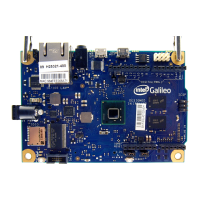Hardware 3
Hardware
1.1: Overview
The Intel Galileo is a microcontroller which is a small computer that is meant to control other electron-
ics. A computer is something you can program to do math or logical sequences. Programming is just
how you tell a computer what to do. You can tell your computer “make a game” but it won’t know what that
means. You have to go through and tell the computer what to do in a language the computer understands
and give it step-by-step instructions.
But, if you learn how to program, you can make your microcontroller do all kinds of things. People have made
robots, cool lighting projects, and much more, do a search for ‘arduino projects’ and you’ll see all kinds of
cool things. (Arduino is another example of a microcontroller that is used commonly. There are a lot of open
source codes and resources available for Arduinos and you can use many of them with your Galileo!)
Learning programming is like learning a new language, however, you have to start simple. This activity is a
rst start. We will make a light blink on and o on your microcontroller board.
1.2: Installing / Setting Up
Follow these three sections to properly install your Galileo and have it communicate with your computer:
• Installing Software
• Driver Installation
• Firmware
Now you are ready to get started!
At this point, plug your Galileo into a power source (Lesson 1, Figure 1), the power light should turn on. Wait a
few seconds and the light labeled “usb” will turn on. Once it is turned on, connect the Galileo to the computer
using a micro usb cable. Make sure you connect the power before connecting the USB cable.
1: Make your Galileo Blink
Lesson 1 Figure 1

